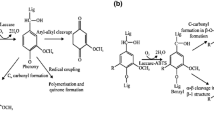Abstract
In thermal printing, bisphenol A (BPA) functions chemically as a developer and reacts with white or colorless dyes in the presence of heat, converting them to a dark color. BPA can transfer readily to skin in small amounts from these papers. Its damage to environment and organisms has caused an extensive concern. In the present study, thermal paper used at the local automated teller machine counters of India were analyzed for the presence of BPA, and the capability of the paper to produce estrogenicity were assessed using a yeast two-hybrid assay experimental system. The study also focused on eliminating the endocrine-disrupting properties with partially purified laccase from newly isolated ascomycete fungi. The results indicate that these papers can produce estrogen hormone-like effect on experimental systems. It should be noted that on a daily basis, tons of such receipts are being dumped in the environment. Estrogenic properties of thermal paper were effectively removed from the reaction mixture within 3 h of incubation with the partially purified enzyme. We propose the utilization of waste thermal paper as a cheap substrate for laccase production for a safer and cleaner environment.





Similar content being viewed by others
References
Liao, C., & Kannan, K. (2011). Environmental Science and Technology, 45, 6761–6768.
Geens, T., Goeyens, L., Kannan, K., Neels, H., & Covaci, A. (2012). Science of the Total Environment, 435–436, 30–33.
Liao, C., Liu, F., & Kannan, K. (2012). Environmental Science and Technology, 46, 6515–6522.
Mendum, T., Stoler, E., van Benschoten, H., & Warner, J. C. (2011). Green Chemical Letters Review, 4, 81–86.
Schwartz, A. W., & Landrigan, P. J. (2012). Environmental Health Perspectives, 120, a14–a15.
Biedermann, S., Tschudin, P., & Grob, K. (2010). Analytical and Bioanalytical Chemistry, 398, 571–576.
Zalko, D., Jacques, C., Duplan, H., Bruel, S., & Perdu, E. (2011). Chemosphere, 82, 424–443.
Liao, C., & Kannan, K. (2011). Environmental Science and Technology, 45, 9372–93790.
Vinggaard, A. M., Korner, W., Lund, H. K., Bolz, U., & Petersen, J. H. (2000). Chemical Research in Toxicology, 13, 1214–1222.
Hohne, C., & Puttmann, W. (2008). Environmental Science and Pollution Research, 15, 405–416.
Fukazawa, H. (2001). Chemosphere, 44, 973–979.
Zhang, Z., Alomirah, H., Cho, H.-S., Li, Y. F., Liao, C., Minh, T. B., Mohd, M. A., Nakata, H., Ren, N., & Kannan, K. (2011). Environmental Science and Technology, 45, 7044–7050.
Lee, Y. M., Seong, M. J., Lee, J. W., Lee, Y. K., Kim, T. M., Nam, S. Y., Kim, D. J., Yun, Y. W., Kim, T. S., Han, S. Y., & Hong, J. T. (2007). Journal of Veterinary Science, 8, 27–38.
Murray, T. J., Maffini, M. V., Ucci, A. A., Sonnenschein, C., & Soto, A. M. (2007). Reproductive Toxicology, 23, 383–390.
Taylor, J. A., vom Saal, F. S., Welshons, W. V., Drury, B., Rottinghaus, G., Hunt, P. A., Toutain, P. L., Laffont, C. M., & VandeVoort, C. A. (2011). Environmental Health Perspectives, 119, 422–430.
vom Saal, F. S., & Hughes, C. (2005). Environmental Health Perspectives, 113, 926–933.
Zsarnovszky, A., Le, H. H., Wang, H. S., & Belcher, S. M. (2006). Endocrinol, 146, 5388–5396.
Balakrishnan, B., Henare, K., Thorstensen, E. B., Ponnampalam, A. P., & Mitchell, M. D. (2010). American Journal of Obstetrics and Gynecology, 202, 393.e1–e7.
Prasanth, G. K., Divya, L. M., & Sadasivan, C. (2012). Human and Ecological Risk Assessment. doi:10.1080/10807039.2012.683720.
Prasanth, G. K., Divya, L. M., & Sadasivan, C. (2010). Journal of Applied Toxicology, 30, 769–774.
Modaressia, K., Taylorb, K. E., Bewtraa, J. K., & Biswas, A. (2005). Laccase-catalyzed removal of bisphenol-A from water Protective effect of PEG on enzyme activity. Water Research, 39, 4309–4316.
Takao, S., Kato, K., Yokogawa, Y., Nishida, M., & Yamashita, N. (2004). Journal of Bioscience and Bioengineering, 98, 64–66.
Uchida, H., Fukuda, T., Miyamoto, H., Kawabata, T., Suzuki, M., & Uwajima, T. (2001). Biochemical and Biophysical Research Communications, 287, 355–358.
Cuoto, S., & Herrera, J. L. (2006). Biotechnology Advances, 2, 500–513.
Fukuda, T., Uchida, H., Takashima, Y., Uwajima, T., Kawabata, T., & Suzuki, M. (2001). Biochemical and Biophysical Research Communications, 284, 704–706.
Sole, M., Muller, I., Pecyna, M. J., Fetzer, I., Harms, H., & Schlosser, D. (2012). Applied and Environmental Microbiology, 78, 4732–4739.
Wei, D., Houtman, C. J., Kapich, A. N., Hunt, G. C., Cullen, D., & Hamme, K. E. (2010). Applied and Environmental Microbiology, 76, 2091–2097.
Routledge, E. J., & Sumpter, J. P. (1997). Journal of Biological Chemistry, 272, 3280–3288.
Acknowledgments
HPLC facilities in the Department of Biotechnology and Microbiology, Kannur University is acknowledged.
Conflict of interest
There are no conflicts of interest in the opinion given in the manuscript.
Author information
Authors and Affiliations
Corresponding author
Rights and permissions
About this article
Cite this article
Divya, L.M., Prasanth, G.K. & Sadasivan, C. Elimination of Estrogenic Activity of Thermal Paper Using Laccase from Trichoderma sp NFCCI-2745. Appl Biochem Biotechnol 169, 1126–1133 (2013). https://doi.org/10.1007/s12010-012-0016-y
Received:
Accepted:
Published:
Issue Date:
DOI: https://doi.org/10.1007/s12010-012-0016-y




